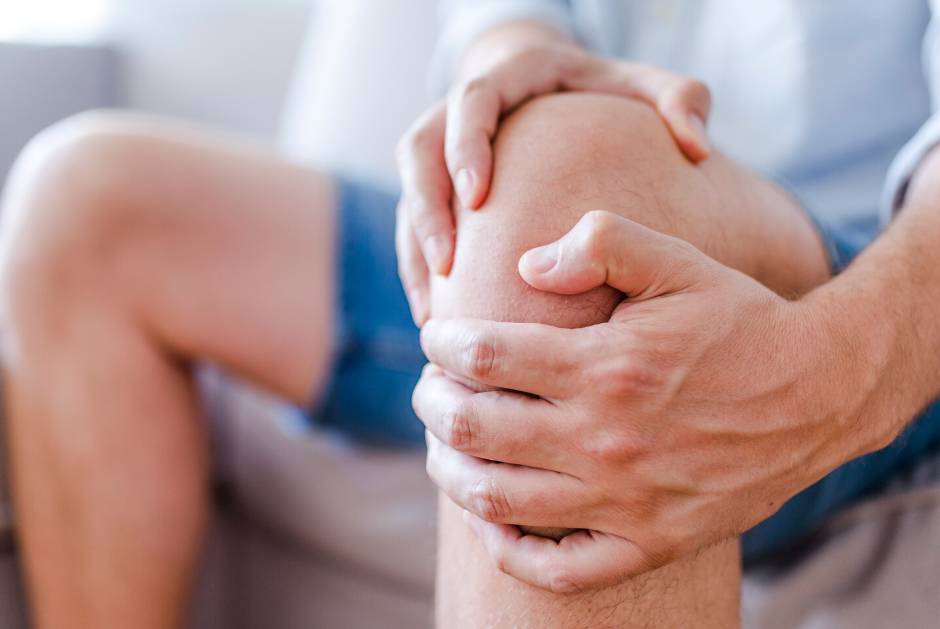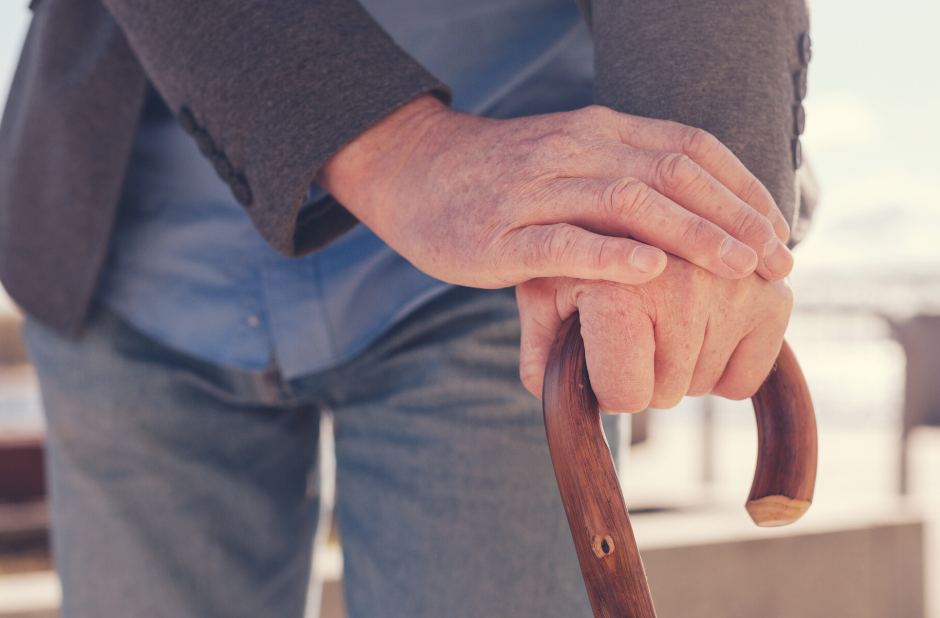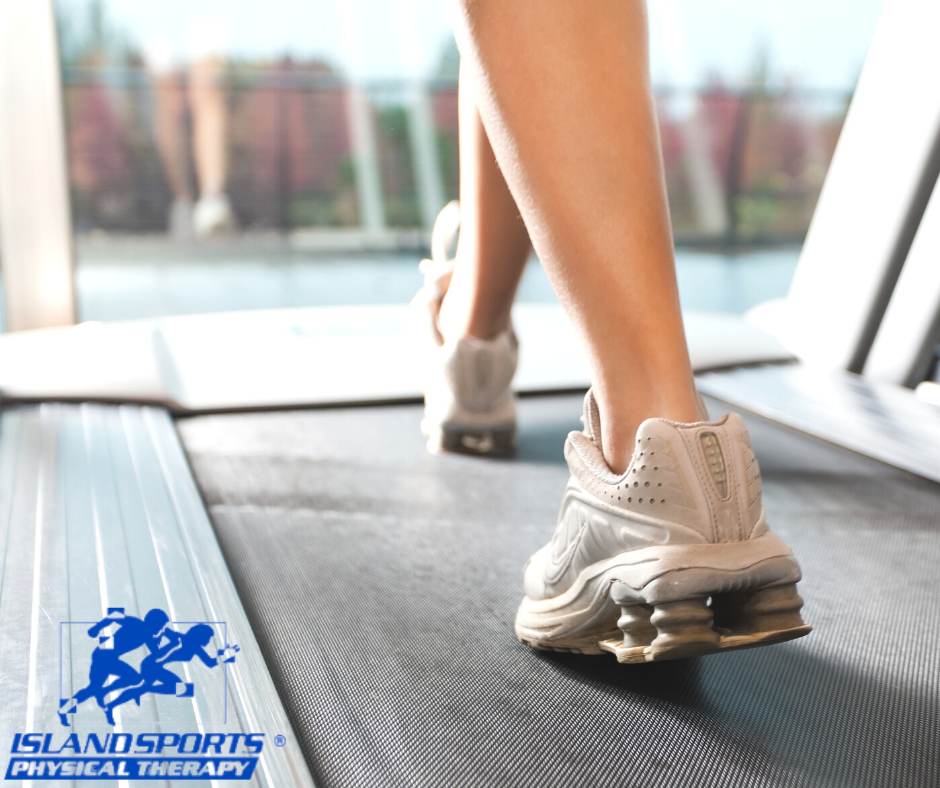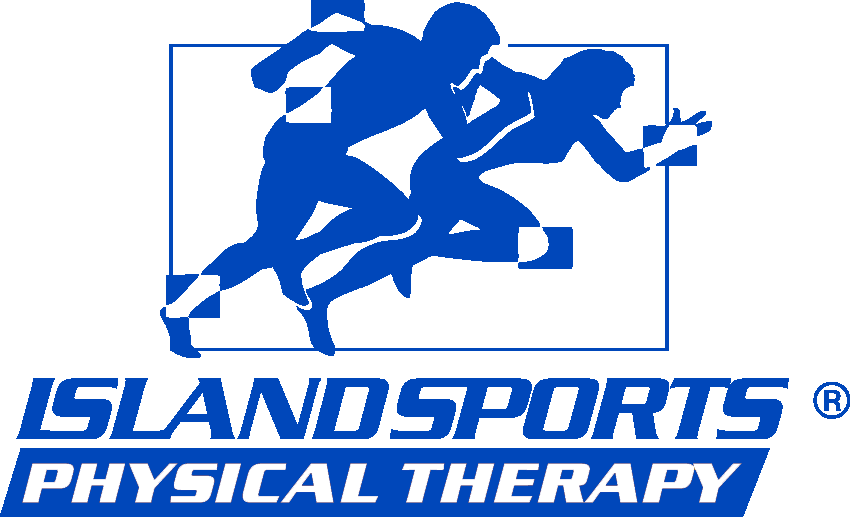Although most offices have reopened, many of us are still working from home some days of the week to maintain safe social distancing. While the elimination of a daily commute may be positive, if you do not have the right setup, working from home will cause more harm than good. Fortunately, our team at Island Sports Physical Therapy can help with this. We’d like to share some tips on how to make your work from home setup more ergonomic, so you can avoid injury.

The Importance Of Posture
It’s easy to overlook how important posture is when it comes to the workplace. Whether it be at your office, or from your own home, when your setup is not ergonomically sound, issues are not far behind. Having poor posture while you’re working can lead to a wide array of issues, which include:
- Neck pain
- Back pain
- Spinal misalignments
- Weakness
- Limited range of motion
Focus On Eye Level
The first step in improving your work from home setup is to focus on having your computer screen at eye level. Many have traded desks for living room tables as a sudden shift in the workplace was not expected. While this may seem like no issue, your tables at home were likely not designed for work. To make up for this, our team recommends stacking books under your laptop to raise it to eye level or purchasing a laptop stand.
Avoid The Bed
The urge to spend your workday in bed or lying on the couch can be great, but you must do your best to avoid this. Working while lying down offers little to no support for your body. It also puts your body in awkward positions when trying to look at and type on your laptop. Doing this will be detrimental to your posture potentially leading to pain or discomfort.
Pillows And Rolled Up Towels
Just like the tables at your home were not designed with work in mind, your seats more than likely were not designed to be sat in for an entire workday. Trying to do so will lead to many bouts of pain. If you’re not willing to purchase an office chair for your home, there are ways to make your current chair more suitable. Below are two examples of how to do so:
- Place a thin pillow underneath you to make the chair more comfortable.
- Place a rolled-up towel behind your lower back to help keep your spine straight.
Make Sure To Take Breaks
Even when you’re working from home, it’s important to remember that you’re entitled to breaks. These breaks should become a part of your workday routine to help prevent pain. Taking a three to five-minute break every 30 minutes to move around will allow you to remain healthy and avoid complications.
Schedule An Appointment
Unfortunately, even if you take all the steps to make your work from home setup ergonomically friendly, issues can still arise. If this happens to you, do not hesitate to schedule an appointment for physical therapy with our team. By allowing us to evaluate and treat your bodily discomfort, you’ll find the relief you desperately need. Some of the benefits you’ll receive from working with us include:
- Regained strength
- Improved flexibility
- Increased range of motion
- Elimination of pain
Contact Us
If you’re unsure how to make the most out of working from home, our team at Island Sports Physical Therapy is here to help. We’ll provide you with advice on making your home more ergonomic, and can offer treatment should pain ever arise. For more information or to schedule an appointment for treatment, contact us today.
What is Whiplash?

Whiplash is caused by an abrupt, forceful back-and-forth movement of the neck, most often caused by car accidents. When whiplash occurs, intervertebral joints, discs, ligaments, cervical muscles, and nerve roots may become damaged.
Physical therapists at Island Sports Physical Therapy are able to diagnose and treat your whiplash so that you can return to your comfortable, everyday life! Our staff has plenty of experience working with patients who recently experienced a car accident and have suffered whiplash, soft tissue damage, and other ailments.
Do I Have Whiplash?
If you have recently been in a car accident, or suffered from an involuntary hyperextension of the neck, and are experiencing strain or pain in your neck, you may have developed whiplash. The symptoms of whiplash are usually delayed up to one day after the accident. These are just some of the common symptoms associated with whiplash:
- Stiff neck.
- Headache.
- Neck ache.
- Lower back pain.
- Dizziness.
- Difficulty concentrating.
- Shoulder pain or pain between shoulder blades.
- Irritability/Trouble sleeping.
- Tingling or numbness in the limbs.
- Memory problems.
If you’re experiencing any of these symptoms, consulting with one of our expert physical therapists could be your solution. Of the many services that we offer, strength training and fitness programming could be an avenue for you to pursue.
How is Whiplash Diagnosed?
In order to determine whether or not you are suffering from whiplash, the doctors at Island Sports Physical Therapy will do a physical examination of your head, arms, and neck. They will assess where your pain or discomfort is and which movements trigger this discomfort. In diagnosing whiplash, your physical therapist will assess just a few of the following:
- Your range of motion in your neck and shoulders.
- The degree of pain and tenderness in your neck, shoulders, and back.
- The strength of your muscles, reflexes, and sensations in your limbs.
Next, your therapist may provide a further evaluation with the use of image testing. X-rays, computerized tomography (CT) scans, or magnetic resonance imaging (MRI) are tests that may be used.
If it is determined that you are suffering from whiplash, your physical therapist will construct a treatment plan of special exercises to ensure that you recover properly.
How Physical Therapy Helps With Whiplash?
Whiplash can cause severe and, at times, debilitating pain. If left untreated, there is a risk for chronic pain and soreness in the neck for extended periods of time, and over-exertion of the muscles affected. While over-the-counter pain medications like ibuprofen may help to temporarily relieve pain, it is important to get the proper treatment to ensure a healthy recovery, and most doctors recommend seeing a physical therapist.
At Island Sports Physical Therapy, we will assess your pain and the extent of your injury. With whiplash, our main goal is for you to return to your normal range of motion, and to alleviate your pain. We will use a variety of exercises like neck rotations or bending to help stretch and strengthen the damaged muscles, as well as deep-tissue massage to help soothe them.
With some whiplash cases, doctors will use hot-and-cold therapy. The heat helps to get increased blood flow to the affected area, which brings needed oxygen and helps to remove waste byproducts. When cold temperatures are introduced, inflammation, muscle spasms, and pain are reduced.
Additionally, your physical therapist will recommend certain at-home treatments like icing, heating pads, proper rest, and at-home exercises.
Where to Get Physical Therapy for Whiplash?
With six locations across Long Island, Island Sports Physical Therapy is here to help. Our dedicated team at Island Sports Physical Therapy has been treating patients who suffer from whiplash and guiding them to recovery for years. Proper treatment is essential to relieving neck pain and ensuring healthy muscle and nerve recovery.
Don’t continue to suffer and don’t leave your whiplash untreated! Visit our website for more information on our treatment plans, or give us a call to make an appointment today!

A Walk in The Park: Walking Safety
The team at Island Sports Physical Therapy encourages a healthy lifestyle. As spring blooms, the outdoors beckon us. The longer days, ample sunshine, and warmer temperatures provide us with an excellent opportunity to follow that calling. Add a good friend or spouse to your session and you’re primed for success. Walking is an excellent starting point to get re-adjusted to an exercise routine. Studies have shown that simply walking creates both physical and psychological benefits, such as improving cardiovascular health and increasing mood. Walking does not require equipment or special skill and can be performed at any time.
What are some factors I should consider before taking a walk?
As with any exercise routine, be sure to have your physician clear you to begin. Next, having goals, both short-term and long-term, are key. It’s even more important to progressively plan each of your sessions so that it leads to the achievement of the ultimate goal. Here are some factors to consider:
Distance and Pace
How far and how fast your walk should be is a matter of personal choice and your goals. While many studies advocate for 30-minutes of brisk walking (3-4 mph), five days per week, others look to heart rate as the primary factor. Typically an individual’s heart rate, or pulse, can be detected with two fingers just below the jawline. Activity that raíses heart rate within 55%-70% of an individual’s maximum heart rate or beats per minute is effective in developing physical benefits. The maximum heart rate can be determined using the equation: 220 minus age = maximum heart rate/minute. For example, a 55-year old’s maximum heart rate is 165. So, ideally, their walk should elicit a heart rate range of 90 – 115 beats per minute. Wearable technology, such as watches, monitors, and bands, has been a tremendous help in accurately detecting proper heart rate ranges. Physiologically, an increase in heart rate also leads to an increase in perspiration, increased blood flow and increased breathing rate. That means, if you’re engaged in a conversation, you may have some level of breathlessness. An inability to talk most likely means your pace is too vigorous. Lastly, the number of steps can help determine the level of intensity. Studies indicate that a walking pace of 100 steps/minute is moderately intense.
Outdoor Surface
Depending on the location of your walk, the option to choose the type of surface or terrain will play a role in your exercise intensity. Often, running up hills will increase the exercise intensity. Further, the ground surface plays a role in the stresses that are placed on the body.
Here are some options for your consideration:
- Road/Sidewalk: Perhaps the easiest and most convenient location to start walking is right outside your door. Roads and/or sidewalks, while convenient, do pose a traffic safety concern. As an alternative, many Long Island golf courses allow residents to walk the circuitous cart paths during certain hours. Be aware that continual walks on hard pavement may exacerbate lower-body injuries, like shin splints, or lower back pain. The Island Sports Physical Therapy team is available to provide an evaluation of those injuries before implementing a walking exercise routine.
- Track: Another safe option for many is an outdoor track. Local Long Island communities have athletic facilities that often include a 400-meter track open for public use. Four laps total one mile. This flat, forgiving surface is ideal for beginners.
- Grass/Trails: Long Island has diverse landscapes and a multitude of parks that allow you to enjoy scenery and nature. As a benefit, the softer terrain creates less impact on joints.
- Beach: Whether it’s the North Shore or South Shore of Long Island, the beaches can enhance the benefit of your walks. Sand will challenge your balance and increase the amount of work your muscles and joints, especially your calves and ankles, require to propel your body over the ground.
Apparel
Spring weather can be fickle with temperatures changing quickly. Be sure to layer both your upper and lower body. Choose lightweight, moisture-wicking materials that are closer to your skin with a breathable, water-repellent or water-resistant layer atop that. Hats and gloves are still advisable for brisk mornings. Opt for reflective clothing when walking during the dawn or dusk hours.
Consider your shoewear. The foot and lower leg distribute the forces that the ground places upon them during activity, especially when on the pavement. Properly fitted and appropriate shoewear is a vital extension of your foot. It helps correct any biomechanical abnormalities that your foot and lower body may have. Your shoe selection may be dependent on the terrain, but should probably include:
- The proper outsole, the undersurface of the shoe that makes contact with the ground, should only bend at the ball of the foot, also known as the transverse metatarsal arch. Rubber is usually the best. Trail walking shoes may incorporate a more rigid outsole.
- Mid-sole: This gel, air or foam portion is responsible for the distribution of forces from the ground. Some shoes incorporate a reinforced medial layer for those individuals who tend to overpronate and/or have flat feet, also known as pes planus.
- Lacing system: How you tie your shoe may help the shoe fit better, ultimately preventing overuse injuries. Be sure that the toe box (the front portion of the shoe) fits snuggly but isn’t too tight, which may cause blisters and neuromas.
New Activity Considerations
Proper walking cadence and patterns are key to incorporate efficient muscle sequencing. The muscles located in the rear of your lower body – calves, hamstrings, and glutes – should work as a unit to control effort, balance, and stability. Thus, as the walking pattern progresses, consider these tips:
- Foot and Ankle: Land on the heel, rolling through the foot and push off the inside two toes.
- Knee and Hip: When landing, maintain a “soft” knee and hip to aid in your body accepting the ground forces. When pushing off, focus on contracting the gluteus muscle (buttock). It’s the primary muscle group responsible for forwarding movement.
- Shoulders, Head and Neck: Maintaining a head straight, eyes forward posture will keep your spine aligned. Focus on keeping the shoulder blades (scapulae) pitched backward, yet allow for a natural swing. To increase the walking pace, bend the elbows to a 90-degree angle and swing the shoulders comfortably. This technique is especially useful on hilly terrain.
Self Care after Activity
As with any new activity or increase in exercise intensity, there may be some initial soreness or discomfort in the stressed areas of the body. While this is usually temporary, gentle stretching and the use of a cold application for 20-30 minutes (no longer) every 60-90 minutes can help alleviate this discomfort. Should the pain or discomfort last longer than 24-48 hours, the Island Sports Physical Therapy team can help identify the cause and create a physical therapy plan to get you back on track.
What Causes Abnormal Gait?

For many people, walking is an easy and uncomplicated activity. However, the people who fall into this category should not take their ease for granted. Some patients suffer from what is known as abnormal gait, which makes walking a more arduous task than expected. At Island Sports Physical Therapy, our team of experts will work diligently to correct your gait issues. If you are noticing walking difficulties, we recommend going through a regimen of physical therapy in Commack to help get the care you need.
What is Abnormal Gait?
The word “gait” refers to one’s ability to walk. Abnormal gait occurs when your body is unable to walk without issue. After being diagnosed with this condition, there is a range of outcomes you can face. Some patients will see their gait problems resolve themselves on their own. For others, this may be permanent. However, physical therapy in Commack can be used to limit the chances of permanent issues and discomfort from taking place.
Types Of Abnormal Gait
As previously stated, abnormal gait is an unfortunate circumstance that limits your body’s ability to walk without issue. Something as simple as suffering from a limp will be classified as abnormal gait. However, there are five types of abnormal gait you can be categorized into. These types include:
- Spastic Gait: This gait issue will make a person appear stiff as they walk. It is the result of a person being unable to walk without dragging their feet.
- Scissors Gait: If a person suffers from a leg that bends inward, this is a likely gait problem they will face. Scissors gait takes place when a person’s legs cross or hit each other as they’re walking.
- Steppage Gait: When dealing with steppage gait, a person’s feet point down as they’re walking, often causing their toes to drag against the ground.
- Propulsive Gait: Those living with propulsive gait walk with their head or neck perpetually pushed forward.
- Waddling Gait: The name of this gait abnormality lays out exactly what takes place on people suffering from it. It involves taking small steps while swinging the body side to side.
Common Causes Of Abnormal Gait
With there being multiple types of abnormal gait you can suffer from, it stands to reason that there are also many causes. Our team at Island Sports Physical Therapy knows this, which is why we offer physical therapy in Commack to help patients recover from the many common causes of this condition. Below is a list of the most prevalent causes:
- Birth defects.
- Broken bones in the legs and feet.
- Arthritis.
- Tendonitis.
- Shin splints.
- Cerebral palsy.
- Strokes.
How Physical Therapy In Commack Will Help
Physical therapy is a treatment method that relies on the use of physical-based activities to promote healing from within. If your condition is being caused by muscle tightness or imbalance, physical therapy in Commack can be used to help eliminate this! By focusing on increasing your strength, flexibility, and range of motion, our physical therapist can help get you back to walking straight and without issue in no time. They may also recommend the use of assistive devices, such as crutches or braces, to help with your movement while you’re still recovering.
Understanding Gait Disorders and Their Impact
Abnormal gait refers to any irregular walking pattern caused by medical conditions affecting the nervous system, muscles, or joints. Gait disorders can result from conditions like Parkinson’s disease and multiple sclerosis, which affect movement control. Types of gait abnormalities include antalgic gait, a limp caused by pain, and other common gait disturbances linked to neurological and musculoskeletal issues. These conditions can lead to long-term mobility challenges if left untreated. Identifying the underlying cause is crucial for effective management. Treatment options, including physical therapy and assistive devices, can help improve walking ability and enhance overall quality of life.
Contact Us
Gait abnormalities can quickly drag down your quality of life. To help avoid gait problems stopping you from living life to your fullest potential, be sure to contact our team at Island Sports Physical Therapy. We will provide compassionate and individualized care that will vastly improve the outlook of permanently eliminating your abnormal gait. When you’re looking for physical therapy in Commack, there is no better team than ours in the Long Island area.

Preventing Common Baseball Injuries
With spring right around the corner, many athletes have begun to shift their interests to the start of baseball season. The prospect of running onto the field for opening day is exciting for athletes and spectators alike. However, an early-season injury can turn this excitement into dread at a dime’s drop. At Island Sports Physical Therapy, our team of physical therapists wants to stop athletes from suffering a premature end to their season due to injury. By working with the experts at our sports injury clinic near Smithtown, you should be able to avoid falling victim to many common baseball injuries this season.
Common Baseball Injuries:
Baseball is a sport that requires athletes to partake in various throwing and twisting movements throughout each game. These motions can put mass amounts of stress on different parts of the body, potentially leading to devastating injuries and the need to visit our sports injury clinic near Smithtown. Some of the most common injuries faced by baseball players each year include:
- Elbow tendonitis.
- Oblique strains.
- Rotator cuff issues.
- Labral tears.
- Shoulder instability.
Preventing Injuries From Occurring:
Throughout the entirety of any sports season, the chance of sustaining an injury is always present. While at times they are unavoidable, it does not mean that athletes cannot take preventative methods to help reduce the risk of one occurring. The team at Island Sports Physical Therapy knows this, which is why we’d like to provide you with quality care. Below are a few options to consider to help prevent many common baseball injuries:
- Offseason Fitness Training: To prepare for the rigors of each season, athletes should spend the off-season training so they can avoid injuries. At our sports injury clinic near Smithtown, our physical therapists can develop the perfect off-season training program to help baseball players stay in shape and increase their athletic output. Since our physical therapists are trained to understand how the body works, it makes them the perfect trainers!
- Physical Therapy: For many athletes, the desire to play through minor bumps and bruises sustained throughout a season is very common. However, this decision can prove to be detrimental, as it increases the likelihood of an even worse injury taking place. Through the use of stretches and strengthening exercises, our physical therapists can help stop minor injuries in their tracks, getting you back to competing without the need to miss a significant amount of game time.
- Take Time To Warm-Up: While the baseball season extends into the hottest months of summer, the first few weeks take place in March. The cold weather experienced this time of year can cause the muscles to become stiff. Trying to compete in this state is a surefire way to sustain an injury, which is why it is so imperative to always make time for a proper warm-up. By performing a few dynamic stretches and exercises, you’ll increase the blood flow to and flexibility of your muscles, preparing them for the stresses that will be placed on them during the game.
- Use The Right Form: Muscle and ligament injuries are commonplace in baseball. To help limit the amount of stress placed on these areas, make sure you’re using the proper mechanics for your position. Whether you’re running through the outfield tracking a fly ball, or zipping the ball from third base to throw out a runner, using the form you’ve spent countless hours practicing will go a long way in keeping you on the field.
Sports Injury Clinic near Smithtown
At Island Sports Physical Therapy, we combine competence, compassion, and hard work to provide each athlete that comes to our sports injury clinic near Smithtown, with individualized care. We know how upsetting it can be to miss time from your sport due to injury, which is why we strive to do everything in our power to stop this from happening. If you’re interested in learning more about what can be done to prevent common baseball injuries or discovering exactly how our team will be able to treat them, be sure to contact us today!
Conquer Your Winter Workouts Like A Pro!

Those who are committed to their health understand the importance of exercising regularly. However, when winter’s cold, dark months roll around, many of us lose motivation, and our routines often shift due to the weather. Here at Island Sports Physical Therapy, our team wants to help keep you active year-round! That is why we’d like to offer some advice on how to crush your winter workouts like a pro.
The Benefits Of Working Out
While the obvious benefits of working out are staying in shape and maintaining your weight, there are various others that many people often fail to realize. Among the many benefits of working out year-round are:
- Maintaining a healthy weight.
- Boosting your mood and energy levels.
- Building muscles and increasing strength.
- Increasing your cardiovascular endurance.
- Improving your heart health.
Winter Workouts
With colder and shorter days, working out during the winter can be extremely difficult for some people, especially those who choose to enjoy their workouts outside. Our team understands this. However, we want to offer advice on how to push past this hurdle. If you’re able to move past your reservations about winter workouts, your health levels will thank you for doing so. To conquer your winter workout like a pro, we recommend focusing on the following:
- Try to exercise at the same time each day to get your body conditioned to a set schedule.
- Consider working out in the morning before work to do so when it is still light out.
- When working out outside, dress in layers so you can easily regulate your body temperature.
- Make sure your face, hands, and feet are adequately covered when exercising outdoors.
- Drink plenty of fluids, even though you may not feel thirsty due to the cold.
- Don’t try to run or exercise in snow-covered areas.
- Try signing up for free virtual exercise classes so you can stay active without needing to leave your home.
- Visit ISPT for fitness programming, where our team will create a workout routine just for you!
Contact Our Team
There is no reason to slack on your exercise routine when winter rolls around! There are countless ways you can adjust your routine so that you still get a sweat in. Should you need assistance with developing or modifying your workout routine, the team at Island Sports Physical Therapy is here for you! With our fitness programming services, we will create a workout routine that works for you. To learn more, be sure to contact us today!
Does Your Child Need PT?
Like adults, children are susceptible to injuries and conditions that can greatly impede their quality of life, if left untreated. As a parent, the last thing you want for your child is for them to experience pain that prevents them from living their life to the fullest. When you don’t know where to turn, you can put your trust in our Island Sports Physical Therapy team to treat your child’s injury with quality care and service. We offer physical therapy in Ronkonkoma NY as a treatment method for a wide variety of injuries and conditions that may be affecting your child.
What Is Physical Therapy?
Physical therapy is a natural form of treatment that works to ease pain and improve the overall functionality and movement of the body. While it can be paired with other forms of treatment to achieve more optimal results, this form of treatment can also be the primary source of care depending on the injury or condition being treated. During a session of our physical therapy in Ronkonkoma NY, your child will be taught a variety of exercises and stretches by one of our therapists. While first being done at our facility, some exercises and stretches can also be performed at home to expedite the healing process. The main goal of our staff at Island Sports Physical Therapy is to help your child regain strength and range of motion in the area of injury and we will work to develop a personalized plan to do so.
Helping With Development:
While each child develops at their own pace, there are certain developmental milestones that should be achieved by a certain point in their lives. While being a month or two behind the average development curve can be completely natural, you should consider our physical therapy in Ronkonkoma NY if your child is displaying any of the below developmental warning signs:
- Unable to bear weight on their legs after 6 months.
- Only able to turn their head to one side.
- Walking only on their tiptoes for more than 6 months.
- Unable to sit on their own after 8 months.
- Not yet crawling after 12 months.
- They have not begun to walk after 18 months.
Injuries and Conditions:
Whether your child is a developing infant or they are old enough to have started playing school sports, physical therapy in Ronkonkoma NY may be necessary. At Island Sports Physical Therapy, we are committed to doing everything in our power to help your child heal and develop properly. Our staff will develop a personalized care plan if your child is affected by any of the below injuries and conditions:
- Delays in development.
- Cerebral palsy.
- Sports injuries.
- Acute trauma.
- Genetic conditions.
- Effects of in-utero drug or alcohol exposure.
- Limb deficiencies.
- Muscle conditions.
Benefits Of Physical Therapy In Ronkonkoma NY:
As you already know, physical therapy helps to increase strength and range of motion in the affected area. However, there are additional benefits that are commonly associated with physical therapy in children, including:
- Avoid and recovery from surgical operations.
- Treat or prevent sports-related injuries.
- Prevent injuries from reoccurring.
- Relieve pain.
- Increase balance to avoid slips and falls.
- Adapt to an artificial limb.
Physical Therapy In Ronkonkoma NY
As a parent, you never want to see your child suffer from a debilitating injury or condition for an extended period. To help avoid this and improve your child’s quality of life, we offer physical therapy in Ronkonkoma NY is an effective and natural form of treatment. When your child requires this type of care, make our team at Island Sports Physical Therapy your first call. Contact us today to schedule an appointment and take every step possible to ensure that your child can remain happy, healthy, and pain-free!

Recovering From A Torn ACL
Your anterior cruciate ligament, or ACL, is an essential ligament that provides stability to the knee joint. This ligament is one of the most commonly injured areas of the knee, so proper care and precautions are vital for maintenance. Regardless of how you sustained a tear in your ACL, our team at Island Sports Physical Therapy will be there for you throughout the recovery process. We offer personalized treatment plans for a variety of sports-related injuries and other conditions. Contact us when you need Physical Therapy in East Meadow that you can count on.
ACL Surgery:
Most commonly, an ACL tear requires surgery. For example, if your knee buckles when putting weight on it or if you are an athlete, your doctor will most likely determine that surgery is necessary for proper treatment. During the procedure, the surgeon will remove the ligament and use a graft as a replacement. This graft will be comprised of tendon taken from another part of the body, usually the knee or hamstring. In most cases, you will be able to return home later that day, depending upon the severity and the preferences of yourself and the surgeon. Once the surgery has been completed, the next steps towards recovery will be to partake in physical therapy in East Meadow.
Length Of Recovery:
Depending on the severity of the injury, recovery time will vary from patient to patient. For some, the typical recovery period is six to nine months after surgery. For others, it may take between eight months and a full year to make a complete recovery. At Island Sports Physical Therapy, you can undergo physical therapy in East Meadow to help expedite your recovery time and get you back to doing what you love.
Treatment – Physical Therapy in East Meadow:
Taking part in physical therapy after surgery will help to restore strength and stability in the knee. The goals of physical therapy in East Meadow are divided into four phases, which are outlined below:
1. Helping To Heal the Knee: Phase one is all about protection and healing. The main goals are to start the process of restoring range of motion and regaining correct usage of your quadriceps muscles. You will learn to walk properly with your crutches and may even receive neuromuscular electrical stimulation to improve your ability to gently contract your knee.
2. Tossing the Crutches: The goal of this phase is to limit the use of crutches while still protecting the knee. During this phase, exercises to improve control of your quadriceps and increase the strength of your hips and hamstrings will be incorporated into your routine. Hopefully, performing these exercises will allow you to begin walking normally again.
3. Getting Stronger: During this phase, the goal is to build up enough strength to begin walking or even lightly jogging. This will be the time where your physical therapist will test the integrity of the repaired knee. If you are pain-free and it is determined that your knee is stable, you may be allowed to begin jogging.
4. Almost Back To Normal: In this final phase of physical therapy, running and normal physical activity can slowly be incorporated back into your life. However, it is important to remember not to overdo this, as pushing too hard can often reverse any progress you have made.
Island Sports Physical Therapy in East Meadow:
Throughout the rehabilitation and recovery process, it is important to listen to your body. Some patients may be ahead of schedule while recovering, while for others it may take longer than usual. At Island Sports Physical Therapy, our team will work to develop the perfect recovery plan to get you back on your feet. We can help you reach your recovery goals within a safe and appropriate timeframe. Don’t hesitate to schedule an appointment with us to begin your journey to recovery today!

Physical Therapy For Parkinson’s Disease
Whether it be affecting you or a loved one, Parkinson’s disease is a difficult disease to have to manage when it becomes a part of your life. Tight muscles, tremors, or difficulty balancing may be an everyday occurrence. At Island Sports Physical Therapy, our team of skilled physical therapists can help to improve the quality of life of those suffering from this condition. While it may not be the cure, our physical therapy in Huntington Station can help to manage any movement issues and face this disease head-on with a personalized plan of attack centered around the patient.
How Can Physical Therapy in Huntington Station Help?
The main goal of physical therapy is to build strength, flexibility, balance, and coordination. Your physical therapist will execute an overall evaluation of your condition and determine the steps necessary to move forward for treatment. During your sessions, you may receive education on some of the following:
- Avoid falls.
- Get in and out of bed easier.
- Go up and down stairs properly.
- Stretch your muscles to improve range of motion.
- Walk without shuffling.
Types of Physical Therapy for Parkinson’s Disease:
At Island Sports Physical Therapy, we offer many different types of physical therapy in Huntington Station that can help to better manage Parkinson’s disease, including:
- Amplitude Training: Since Parkinson’s disease causes movements to become progressively smaller, amplitude training may be done to combat this symptom. Training will consist of putting the body through a variety of exaggerated movements to open up any range of motion that may have been diminished due to this disease.
- Balance Work: Balance and coordination are some other things that Parkinson’s disease may affect and make difficult. Our team will introduce a variety of exercises to help in regaining this balance and allowing you to move around with more confidence and ease.
- Strength Training: Both age and Parkinson’s disease can lead to a deterioration of strength. Physical therapy can be used as a means to regain any strength that has been washed away by this condition.
- Stretching: Parkinson’s disease can cause muscles to tighten, making it difficult to walk and move around. A physical therapist can introduce a stretching regimen to help loosen these muscles and make movement a bit easier.
Schedule an Appointment For Physical Therapy in Huntington Station :
If you’re looking for help in managing Parkinson’s disease, the team at Island Sports Physical Therapy is here to help. Physical therapy is a great option when dealing with progressive disorders. By contacting us, you can take the first steps in managing this unfortunate condition today.


Achieve Your New Year’s Fitness Goals With Us!
Every year, millions of people set a New Year’s resolution to get in better shape. While this is very admirable, very few end up reaching their goals on their own. If you’re one of the millions who will be looking to improve their fitness in 2021, our team at Island Sports Physical Therapy will be there to help. In addition to our Fitness Programming services, we can provide the necessary tips to reach your goals as we enter a new year!
Set Attainable Goals
One of the biggest deterrents when it comes to improving one’s physical fitness is setting unrealistic goals. While goals are an essential factor in keeping people motivated, if you set ones that are difficult to attain, you’re more likely to give up. To avoid this, our team recommends setting some of these healthily attainable fitness goals for 2021:
- Perform at least 30 minutes of exercise three to five times a week.
- Aim to lose half a pound each week.
- When doing free weight exercises, increase the amount of weight or the reps each week.
- Try performing one new workout each month.
- Reduce your cholesterol and resting heart rate.
Make A Meal Plan For The Week
While exercising is important, monitoring your diet also plays a large role in reaching your fitness goals. Combining eating right with exercising regularly will allow you to more easily burn fat, gain muscle, and improve your energy levels. The easiest way to stick to a clean diet is to set a meal plan at the beginning of each week. By preparing a week’s worth of meals ahead of time, you’re less likely to eat out and stray from your diet. It also helps save on time, eliminating one of the top excuses many people have for not eating clean.
Try Our Fitness Programming
Even if you have all the intentions of sticking to your fitness plan, this can be difficult for many people to do on their own. Working with a team of professional trainers is a great way to help crush your goals. Whether you are looking to increase your athletic output or get in better shape, our team at Island Sports Physical Therapy will help. By utilizing some of our below state of the art equipment when you visit us for Fitness Programming, you’ll see vast improvements being made:
- Precor ellipticals.
- Matrix bicycles.
- Nusteps ross rainers.
- Resistance bands.
- Free weight.
- Cybex isokinetic therapy.
Contact Us Today!
Although sticking to your New Year’s fitness goals can be a daunting task, it is not impossible. If you’re looking for that extra push you need to reach your goals, please don’t hesitate to contact our team at Island Sports Physical Therapy to learn more about our Fitness Programming service and how it can help you reach your goals today!

